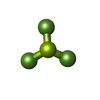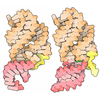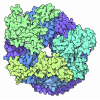+ データを開く
データを開く
- 基本情報
基本情報
| 登録情報 | データベース: PDB / ID: 9er2 | |||||||||
|---|---|---|---|---|---|---|---|---|---|---|
| タイトル | PolII-TCR-STK19 structure. | |||||||||
 要素 要素 |
| |||||||||
 キーワード キーワード | TRANSCRIPTION / Complex / DNA repair | |||||||||
| 機能・相同性 |  機能・相同性情報 機能・相同性情報negative regulation of double-strand break repair via nonhomologous end joining / regulation of transcription-coupled nucleotide-excision repair / nucleotide-excision repair complex / positive regulation of single strand break repair / regulation of transcription elongation by RNA polymerase II / B-WICH complex / DNA protection / single strand break repair / positive regulation by virus of viral protein levels in host cell / Formation of RNA Pol II elongation complex ...negative regulation of double-strand break repair via nonhomologous end joining / regulation of transcription-coupled nucleotide-excision repair / nucleotide-excision repair complex / positive regulation of single strand break repair / regulation of transcription elongation by RNA polymerase II / B-WICH complex / DNA protection / single strand break repair / positive regulation by virus of viral protein levels in host cell / Formation of RNA Pol II elongation complex / Formation of the Early Elongation Complex / Transcriptional regulation by small RNAs / RNA Polymerase II Pre-transcription Events / TP53 Regulates Transcription of DNA Repair Genes / FGFR2 alternative splicing / RNA polymerase II transcribes snRNA genes / mRNA Capping / mRNA Splicing - Minor Pathway / Processing of Capped Intron-Containing Pre-mRNA / RNA Polymerase II Promoter Escape / RNA Polymerase II Transcription Pre-Initiation And Promoter Opening / RNA Polymerase II Transcription Initiation / RNA Polymerase II Transcription Elongation / RNA Polymerase II Transcription Initiation And Promoter Clearance / RNA Pol II CTD phosphorylation and interaction with CE / Estrogen-dependent gene expression / Formation of TC-NER Pre-Incision Complex / Dual incision in TC-NER / Gap-filling DNA repair synthesis and ligation in TC-NER / mRNA Splicing - Major Pathway / double-strand break repair via classical nonhomologous end joining / response to superoxide / epigenetic programming in the zygotic pronuclei / ATP-dependent chromatin remodeler activity / spindle assembly involved in female meiosis / photoreceptor cell maintenance / Cul4-RING E3 ubiquitin ligase complex / nuclear lumen / UV-damage excision repair / positive regulation of Ras protein signal transduction / positive regulation of DNA-templated transcription, elongation / response to UV-B / RNA polymerase binding / biological process involved in interaction with symbiont / regulation of mitotic cell cycle phase transition / WD40-repeat domain binding / positive regulation of transcription by RNA polymerase III / Cul4A-RING E3 ubiquitin ligase complex / Cul4B-RING E3 ubiquitin ligase complex / ubiquitin ligase complex scaffold activity / positive regulation of transcription by RNA polymerase I / negative regulation of reproductive process / negative regulation of developmental process / RNA polymerase II complex binding / cullin family protein binding / maintenance of transcriptional fidelity during transcription elongation by RNA polymerase II / site of DNA damage / viral release from host cell / protein tyrosine kinase activator activity / RNA Polymerase I Transcription Initiation / pyrimidine dimer repair / response to X-ray / ATP-dependent activity, acting on DNA / positive regulation of transcription initiation by RNA polymerase II / ectopic germ cell programmed cell death / transcription by RNA polymerase III / transcription by RNA polymerase I / positive regulation of double-strand break repair via homologous recombination / positive regulation of viral genome replication / RNA polymerase I complex / transcription elongation by RNA polymerase I / RNA polymerase III complex / proteasomal protein catabolic process / transcription-coupled nucleotide-excision repair / response to UV / RNA polymerase II, core complex / tRNA transcription by RNA polymerase III / : / protein autoubiquitination / JNK cascade / translation initiation factor binding / neurogenesis / positive regulation of gluconeogenesis / DNA-directed RNA polymerase complex / DNA-directed RNA polymerase activity / positive regulation of DNA repair / DNA damage checkpoint signaling / transcription elongation factor complex / regulation of DNA-templated transcription elongation / ERCC6 (CSB) and EHMT2 (G9a) positively regulate rRNA expression / response to gamma radiation / nucleotide-excision repair / helicase activity / transcription initiation at RNA polymerase II promoter / DNA-templated transcription initiation / transcription elongation by RNA polymerase II / Recognition of DNA damage by PCNA-containing replication complex / regulation of circadian rhythm / DNA Damage Recognition in GG-NER / base-excision repair 類似検索 - 分子機能 | |||||||||
| 生物種 |  Homo sapiens (ヒト) Homo sapiens (ヒト) | |||||||||
| 手法 | 電子顕微鏡法 / 単粒子再構成法 / クライオ電子顕微鏡法 / 解像度: 3.3 Å | |||||||||
 データ登録者 データ登録者 | Kokic, G. | |||||||||
| 資金援助 |  ドイツ, European Union, 2件 ドイツ, European Union, 2件
| |||||||||
 引用 引用 |  ジャーナル: Cell / 年: 2024 ジャーナル: Cell / 年: 2024タイトル: STK19 facilitates the clearance of lesion-stalled RNAPII during transcription-coupled DNA repair. 著者: Diana van den Heuvel / Marta Rodríguez-Martínez / Paula J van der Meer / Nicolas Nieto Moreno / Jiyoung Park / Hyun-Suk Kim / Janne J M van Schie / Annelotte P Wondergem / Areetha D'Souza / ...著者: Diana van den Heuvel / Marta Rodríguez-Martínez / Paula J van der Meer / Nicolas Nieto Moreno / Jiyoung Park / Hyun-Suk Kim / Janne J M van Schie / Annelotte P Wondergem / Areetha D'Souza / George Yakoub / Anna E Herlihy / Krushanka Kashyap / Thierry Boissière / Jane Walker / Richard Mitter / Katja Apelt / Klaas de Lint / Idil Kirdök / Mats Ljungman / Rob M F Wolthuis / Patrick Cramer / Orlando D Schärer / Goran Kokic / Jesper Q Svejstrup / Martijn S Luijsterburg /       要旨: Transcription-coupled DNA repair (TCR) removes bulky DNA lesions impeding RNA polymerase II (RNAPII) transcription. Recent studies have outlined the stepwise assembly of TCR factors CSB, CSA, UVSSA, ...Transcription-coupled DNA repair (TCR) removes bulky DNA lesions impeding RNA polymerase II (RNAPII) transcription. Recent studies have outlined the stepwise assembly of TCR factors CSB, CSA, UVSSA, and transcription factor IIH (TFIIH) around lesion-stalled RNAPII. However, the mechanism and factors required for the transition to downstream repair steps, including RNAPII removal to provide repair proteins access to the DNA lesion, remain unclear. Here, we identify STK19 as a TCR factor facilitating this transition. Loss of STK19 does not impact initial TCR complex assembly or RNAPII ubiquitylation but delays lesion-stalled RNAPII clearance, thereby interfering with the downstream repair reaction. Cryoelectron microscopy (cryo-EM) and mutational analysis reveal that STK19 associates with the TCR complex, positioning itself between RNAPII, UVSSA, and CSA. The structural insights and molecular modeling suggest that STK19 positions the ATPase subunits of TFIIH onto DNA in front of RNAPII. Together, these findings provide new insights into the factors and mechanisms required for TCR. | |||||||||
| 履歴 |
|
- 構造の表示
構造の表示
| 構造ビューア | 分子:  Molmil Molmil Jmol/JSmol Jmol/JSmol |
|---|
- ダウンロードとリンク
ダウンロードとリンク
- ダウンロード
ダウンロード
| PDBx/mmCIF形式 |  9er2.cif.gz 9er2.cif.gz | 2.1 MB | 表示 |  PDBx/mmCIF形式 PDBx/mmCIF形式 |
|---|---|---|---|---|
| PDB形式 |  pdb9er2.ent.gz pdb9er2.ent.gz | 表示 |  PDB形式 PDB形式 | |
| PDBx/mmJSON形式 |  9er2.json.gz 9er2.json.gz | ツリー表示 |  PDBx/mmJSON形式 PDBx/mmJSON形式 | |
| その他 |  その他のダウンロード その他のダウンロード |
-検証レポート
| アーカイブディレクトリ |  https://data.pdbj.org/pub/pdb/validation_reports/er/9er2 https://data.pdbj.org/pub/pdb/validation_reports/er/9er2 ftp://data.pdbj.org/pub/pdb/validation_reports/er/9er2 ftp://data.pdbj.org/pub/pdb/validation_reports/er/9er2 | HTTPS FTP |
|---|
-関連構造データ
| 関連構造データ |  19909MC M: このデータのモデリングに利用したマップデータ C: 同じ文献を引用 ( |
|---|---|
| 類似構造データ | 類似検索 - 機能・相同性  F&H 検索 F&H 検索 |
- リンク
リンク
- 集合体
集合体
| 登録構造単位 | 
|
|---|---|
| 1 |
|
- 要素
要素
-RNA鎖 , 1種, 1分子 P
| #1: RNA鎖 | 分子量: 4556.836 Da / 分子数: 1 / 由来タイプ: 合成 / 由来: (合成)  Homo sapiens (ヒト) Homo sapiens (ヒト) |
|---|
-タンパク質 , 4種, 5分子 QcMOd
| #2: タンパク質 | 分子量: 28926.500 Da / 分子数: 1 / 由来タイプ: 組換発現 / 由来: (組換発現)  Homo sapiens (ヒト) / 遺伝子: STK19, G11, RP1 / 発現宿主: Homo sapiens (ヒト) / 遺伝子: STK19, G11, RP1 / 発現宿主:  | ||||
|---|---|---|---|---|---|
| #17: タンパク質 | 分子量: 80721.680 Da / 分子数: 2 / 由来タイプ: 組換発現 / 由来: (組換発現)  Homo sapiens (ヒト) / 遺伝子: UVSSA, KIAA1530 / 発現宿主: Homo sapiens (ヒト) / 遺伝子: UVSSA, KIAA1530 / 発現宿主:  Trichoplusia ni (イラクサキンウワバ) / 参照: UniProt: Q2YD98 Trichoplusia ni (イラクサキンウワバ) / 参照: UniProt: Q2YD98#18: タンパク質 | | 分子量: 7272.097 Da / 分子数: 1 / 由来タイプ: 組換発現 / 由来: (組換発現)  Homo sapiens (ヒト) / 遺伝子: ELOF1 / 発現宿主: Homo sapiens (ヒト) / 遺伝子: ELOF1 / 発現宿主:  #21: タンパク質 | | 分子量: 127097.469 Da / 分子数: 1 / 由来タイプ: 組換発現 / 由来: (組換発現)  Homo sapiens (ヒト) / 遺伝子: DDB1, XAP1 / 発現宿主: Homo sapiens (ヒト) / 遺伝子: DDB1, XAP1 / 発現宿主:  Trichoplusia ni (イラクサキンウワバ) / 参照: UniProt: Q16531 Trichoplusia ni (イラクサキンウワバ) / 参照: UniProt: Q16531 |
-DNA-directed RNA polymerase ... , 7種, 7分子 ABCEGIK
| #3: タンパク質 | 分子量: 218889.547 Da / 分子数: 1 / 由来タイプ: 天然 / 由来: (天然)  |
|---|---|
| #4: タンパク質 | 分子量: 133201.625 Da / 分子数: 1 / 由来タイプ: 天然 / 由来: (天然)  |
| #5: タンパク質 | 分子量: 31439.074 Da / 分子数: 1 / 由来タイプ: 天然 / 由来: (天然)  |
| #7: タンパク質 | 分子量: 24644.318 Da / 分子数: 1 / 由来タイプ: 天然 / 由来: (天然)  |
| #9: タンパク質 | 分子量: 19314.283 Da / 分子数: 1 / 由来タイプ: 天然 / 由来: (天然)  |
| #11: タンパク質 | 分子量: 14541.221 Da / 分子数: 1 / 由来タイプ: 天然 / 由来: (天然)  |
| #13: タンパク質 | 分子量: 13310.284 Da / 分子数: 1 / 由来タイプ: 天然 / 由来: (天然)  |
-RNA polymerase II subunit ... , 2種, 2分子 DL
| #6: タンパク質 | 分子量: 16331.255 Da / 分子数: 1 / 由来タイプ: 天然 / 由来: (天然)  |
|---|---|
| #14: タンパク質 | 分子量: 7018.244 Da / 分子数: 1 / 由来タイプ: 天然 / 由来: (天然)  |
-DNA-directed RNA polymerases I, II, and III subunit ... , 3種, 3分子 FHJ
| #8: タンパク質 | 分子量: 14477.001 Da / 分子数: 1 / 由来タイプ: 天然 / 由来: (天然)  |
|---|---|
| #10: タンパク質 | 分子量: 17162.273 Da / 分子数: 1 / 由来タイプ: 天然 / 由来: (天然)  |
| #12: タンパク質 | 分子量: 7655.123 Da / 分子数: 1 / 由来タイプ: 天然 / 由来: (天然)  |
-DNA鎖 , 2種, 2分子 NT
| #15: DNA鎖 | 分子量: 16027.309 Da / 分子数: 1 / 由来タイプ: 合成 / 由来: (合成)  Homo sapiens (ヒト) Homo sapiens (ヒト) |
|---|---|
| #16: DNA鎖 | 分子量: 15824.121 Da / 分子数: 1 / 由来タイプ: 合成 / 由来: (合成)  Homo sapiens (ヒト) Homo sapiens (ヒト) |
-DNA excision repair protein ERCC- ... , 2種, 2分子 ba
| #19: タンパク質 | 分子量: 168673.547 Da / 分子数: 1 / 由来タイプ: 組換発現 / 由来: (組換発現)  Homo sapiens (ヒト) / 遺伝子: ERCC6, CSB / 発現宿主: Homo sapiens (ヒト) / 遺伝子: ERCC6, CSB / 発現宿主:  Trichoplusia ni (イラクサキンウワバ) Trichoplusia ni (イラクサキンウワバ)参照: UniProt: Q03468, 加水分解酵素; 酸無水物に作用; 酸無水物に作用・細胞または細胞小器官の運動に関与 |
|---|---|
| #20: タンパク質 | 分子量: 44107.160 Da / 分子数: 1 / 由来タイプ: 組換発現 / 由来: (組換発現)  Homo sapiens (ヒト) / 遺伝子: ERCC8, CKN1, CSA / 発現宿主: Homo sapiens (ヒト) / 遺伝子: ERCC8, CKN1, CSA / 発現宿主:  Trichoplusia ni (イラクサキンウワバ) / 参照: UniProt: Q13216 Trichoplusia ni (イラクサキンウワバ) / 参照: UniProt: Q13216 |
-非ポリマー , 4種, 15分子 






| #22: 化合物 | ChemComp-ZN / #23: 化合物 | #24: 化合物 | ChemComp-ADP / | #25: 化合物 | ChemComp-BEF / | |
|---|
-詳細
| 研究の焦点であるリガンドがあるか | N |
|---|---|
| Has protein modification | N |
-実験情報
-実験
| 実験 | 手法: 電子顕微鏡法 |
|---|---|
| EM実験 | 試料の集合状態: PARTICLE / 3次元再構成法: 単粒子再構成法 |
- 試料調製
試料調製
| 構成要素 | 名称: Pol II-TCR-STK19 / タイプ: COMPLEX / Entity ID: #1-#17, #19-#21 / 由来: RECOMBINANT |
|---|---|
| 由来(天然) | 生物種:  Homo sapiens (ヒト) Homo sapiens (ヒト) |
| 由来(組換発現) | 生物種:  Trichoplusia ni (イラクサキンウワバ) Trichoplusia ni (イラクサキンウワバ) |
| 緩衝液 | pH: 7.5 |
| 試料 | 包埋: NO / シャドウイング: NO / 染色: NO / 凍結: YES |
| 急速凍結 | 凍結剤: ETHANE |
- 電子顕微鏡撮影
電子顕微鏡撮影
| 顕微鏡 | モデル: TFS GLACIOS |
|---|---|
| 電子銃 | 電子線源:  FIELD EMISSION GUN / 加速電圧: 200 kV / 照射モード: FLOOD BEAM FIELD EMISSION GUN / 加速電圧: 200 kV / 照射モード: FLOOD BEAM |
| 電子レンズ | モード: BRIGHT FIELD / 最大 デフォーカス(公称値): 2500 nm / 最小 デフォーカス(公称値): 500 nm |
| 撮影 | 電子線照射量: 39.6 e/Å2 フィルム・検出器のモデル: FEI FALCON III (4k x 4k) |
- 解析
解析
| CTF補正 | タイプ: PHASE FLIPPING AND AMPLITUDE CORRECTION | ||||||||||||||||||||||||
|---|---|---|---|---|---|---|---|---|---|---|---|---|---|---|---|---|---|---|---|---|---|---|---|---|---|
| 3次元再構成 | 解像度: 3.3 Å / 解像度の算出法: FSC 0.143 CUT-OFF / 粒子像の数: 113958 / 対称性のタイプ: POINT | ||||||||||||||||||||||||
| 拘束条件 |
|
 ムービー
ムービー コントローラー
コントローラー



 PDBj
PDBj







































































